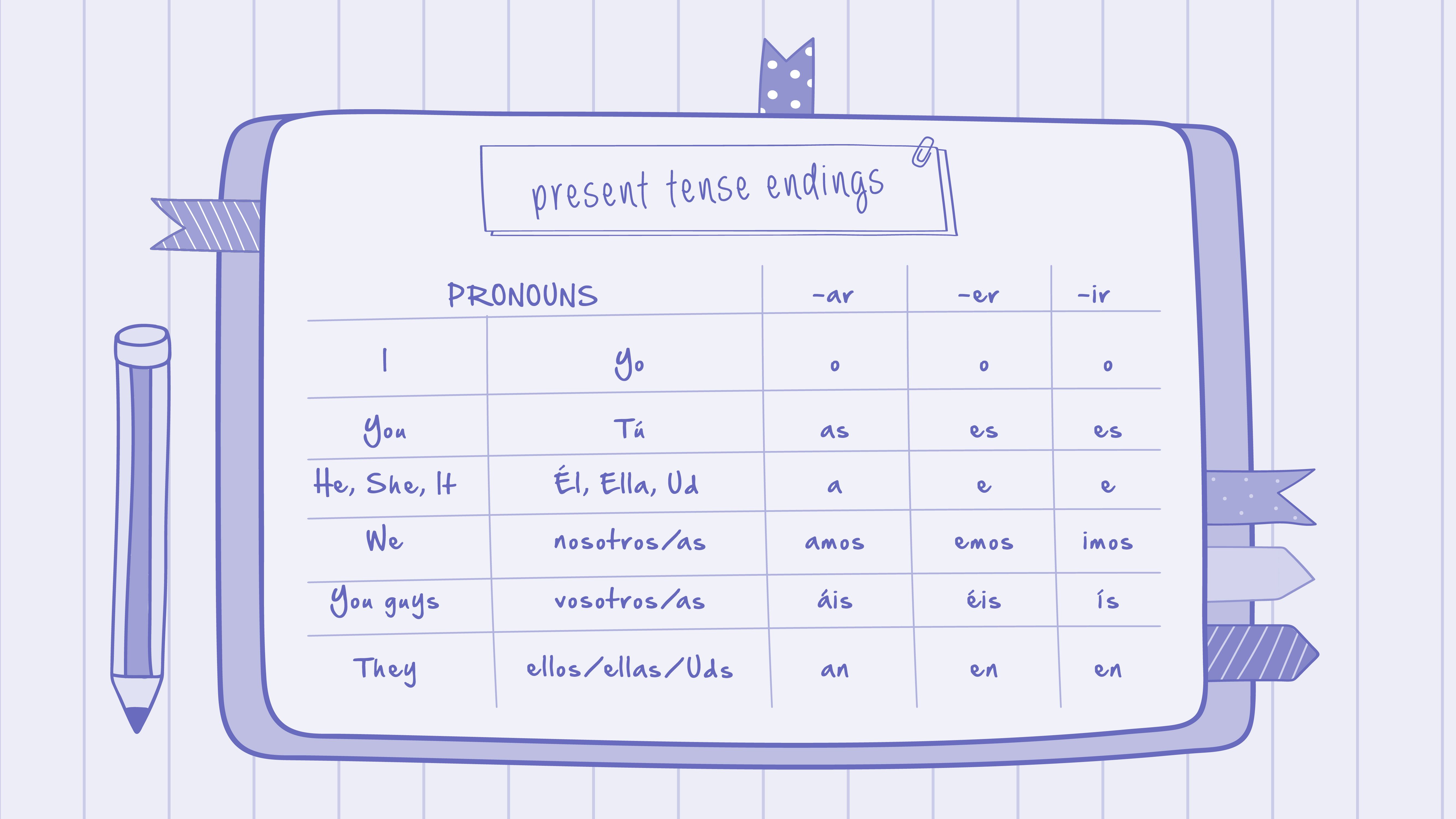
Are you looking to improve your proficiency in Spanish? Well, mastering AR verbs is one of the best ways to do so. AR verbs represent one of the most common and important conjugations in Spanish, used in all kinds of formal and informal conversations.
In this blog post, we're going to discuss what AR verbs are, how to use them correctly, and when to use them. Whether you're a Spanish beginner or an advanced learner, this deep dive into AR verbs will lay an important foundation for you to communicate fluently in any situation!
Learn Spanish with Langster
What Are AR verbs in Spanish?
One essential aspect of Spanish grammar that learners must master is understanding verb conjugation, including AR verbs. AR verbs are some of the most common verbs in Spanish, and they follow a predictable pattern of conjugation.
When conjugating an AR verb in Spanish, you need to drop the AR ending and add a new ending depending on the subject of the sentence. The good news is that most AR Verbs are regular verbs, meaning they follow a standard set of rules.
However, some irregular verbs, such as dar (to give) or estar (to be), change their stem or vowel in the present tense. By learning the AR verbs in Spanish, you'll expand your vocabulary, improve your communication skills, and unleash your inner Spanish speaker.
| Spanish Verb | English Translation | Usage in a Phrase | English Translation |
|---|---|---|---|
| Hablar | To speak | Hablo español. | I speak Spanish. |
| Amar | To love | Amo a mi familia. | I love my family. |
| Bailar | To dance | Bailamos juntos. | We dance together. |
| Caminar | To walk | Camino al trabajo. | I walk to work. |
| Comprar | To buy | Compra el libro. | He buys the book. |
| Estudiar | To study | Estudio para el examen. | I study for the test. |
| Llorar | To cry | Llora de felicidad. | She cries from happiness. |
| Mirar | To look | Miro la televisión. | I watch television. |
| Pintar | To paint | Pinta un cuadro. | He paints a picture. |
| Trabajar | To work | Trabajo en una oficina. | I work in an office. |
| Spanish Verb | English Translation | Usage in a Phrase | English Translation |
|---|---|---|---|
| Hablar | To speak | Hablo español. | I speak Spanish. |
| Amar | To love | Amo a mi familia. | I love my family. |
| Bailar | To dance | Bailamos juntos. | We dance together. |
| Caminar | To walk | Camino al trabajo. | I walk to work. |
| Comprar | To buy | Compra el libro. | He buys the book. |
| Estudiar | To study | Estudio para el examen. | I study for the test. |
| Llorar | To cry | Llora de felicidad. | She cries from happiness. |
| Mirar | To look | Miro la televisión. | I watch television. |
| Pintar | To paint | Pinta un cuadro. | He paints a picture. |
| Trabajar | To work | Trabajo en una oficina. | I work in an office. |
Identifying and conjugating AR verbs in Spanish is a straightforward process. The first step is to distinguish them from other verbs. In Spanish, all infinitive verbs end in either AR, ER, or IR. Those ending in AR are AR verbs. Examples include hablar (to speak), caminar (to walk), and amar (to love).
To conjugate these verbs, you remove the AR ending to find the root of the verb. This root remains constant during conjugation, except for a few special cases. For example, the root of hablar is habl.
Next, you add the ending that corresponds to the subject and tense. For the past tense:
- é,
- aste,
- ó,
- amos,
- aron.
These are used for I, you (singular), he/she/it/you (formal), we, and they/you (plural), respectively. So:
- hablar becomes hablé (I spoke),
- hablaste (you spoke),
- habló (he/she/it spoke),
- hablamos (we spoke),
- and hablaron (they/you plural spoke).

Remember, practice makes perfect. Regular use and exposure to these verbs in context will help solidify your understanding and use of AR verbs in Spanish.
Commonly Used AR Verbs in Spanish
Explore the heart of Spanish communication with a focus on AR verbs. From regular to irregular, we'll navigate the essential verbs shaping everyday Spanish sentences.
Let's dive into their usage and master the art of AR verb conjugation, taking into account the structure of subject-pronoun-verb.
Regular AR Verbs
Regular verb endings follow a set pattern for conjugation, as you can see gustar.
- Yo (I): -o
- Tú (You, informal): -as
- Él/Ella/Usted (He/She/You, formal): -a
- Nosotros/Nosotras (We): -amos
- Vosotros/Vosotras (You all, informal - used in some Spanish-speaking regions): -áis
- Ellos/Ellas/Ustedes (They/You all): -an
Here are some examples of other AR verbs conjugated in the present simple:
Cantar (to sing)
| Cantar | To sing |
|---|---|
| yo canto | I sing |
| tú cantas | you sing |
| él, ella, usted canta | he, she sings or you (formal) sing |
| nosotros, nosotras cantamos | we sing |
| vosotros, vosotras cantáis | you (informal, plural) sing |
| ellos, ellas cantan | they sing |
| Cantar | To sing |
|---|---|
| yo canto | I sing |
| tú cantas | you sing |
| él, ella, usted canta | he, she sings or you (formal) sing |
| nosotros, nosotras cantamos | we sing |
| vosotros, vosotras cantáis | you (informal, plural) sing |
| ellos, ellas cantan | they sing |
Bailar (to dance)
| Bailar | To dance |
|---|---|
| yo bailo | I dance |
| tú bailas | you dance |
| él, ella, usted baila | he, she, you formal dances |
| nosotros, nosotras bailamos | we dance |
| vosotros, vosotras bailáis | you (plural) dance |
| ellos, ellas bailan | they dance |
| Bailar | To dance |
|---|---|
| yo bailo | I dance |
| tú bailas | you dance |
| él, ella, usted baila | he, she, you formal dances |
| nosotros, nosotras bailamos | we dance |
| vosotros, vosotras bailáis | you (plural) dance |
| ellos, ellas bailan | they dance |
Estudiar (to study)
| Estudiar | To study |
|---|---|
| yo estudio | I study |
| tú estudias | you study |
| él, ella, usted estudia | he, she, you (formal) studies study |
| nosotros, nosotras estudiamos | we study |
| vosotros, vosotras estudiáis | you (informal, plural) study |
| ellos, ellas estudian | they study |
| Estudiar | To study |
|---|---|
| yo estudio | I study |
| tú estudias | you study |
| él, ella, usted estudia | he, she, you (formal) studies study |
| nosotros, nosotras estudiamos | we study |
| vosotros, vosotras estudiáis | you (informal, plural) study |
| ellos, ellas estudian | they study |
Irregular AR Verbs

Irregular AR verbs do not follow the standard conjugation rules. Here are some examples:
Dar (To give)
| Dar | To give |
|---|---|
| yo doy | I give |
| tú das | you give |
| él, ella, usted da | he, she gives or you (formal) give |
| nosotros, nosotras damos | we give |
| vosotros, vosotras dais | you (informal, plural) give |
| ellos, ellas, ustedes dan | they, you (formal, plural) give |
| Dar | To give |
|---|---|
| yo doy | I give |
| tú das | you give |
| él, ella, usted da | he, she gives or you (formal) give |
| nosotros, nosotras damos | we give |
| vosotros, vosotras dais | you (informal, plural) give |
| ellos, ellas, ustedes dan | they, you (formal, plural) give |
Estar (to be)
| Estar | To be |
|---|---|
| yo estoy | I am |
| tú estás | you are |
| él, ella, usted está | he, she is or you (formal) are |
| nosotros, nosotras estamos | we are |
| vosotros, vosotras estáis | you (informal, plural) are |
| ellos, ellas, usted están | they, you (formal, plural) are |
| Estar | To be |
|---|---|
| yo estoy | I am |
| tú estás | you are |
| él, ella, usted está | he, she is or you (formal) are |
| nosotros, nosotras estamos | we are |
| vosotros, vosotras estáis | you (informal, plural) are |
| ellos, ellas, usted están | they, you (formal, plural) are |
Gozar (to enjoy)
| Gozar | To enjoy |
|---|---|
| yo gozo | I enjoy |
| tú gozas | you enjoy |
| él, ella goza | he, she enjoys or you (formal) enjoy |
| nosotros, nosotras gozamos | we enjoy |
| vosotros, vosotras gozáis | you (informal, plural) enjoy |
| ellos, ellas, usted gozan | they, you (formal, plural) enjoy |
| Gozar | To enjoy |
|---|---|
| yo gozo | I enjoy |
| tú gozas | you enjoy |
| él, ella goza | he, she enjoys or you (formal) enjoy |
| nosotros, nosotras gozamos | we enjoy |
| vosotros, vosotras gozáis | you (informal, plural) enjoy |
| ellos, ellas, usted gozan | they, you (formal, plural) enjoy |
Understanding how to conjugate AR verbs will significantly enhance your Spanish language proficiency. Remember, practice is the key to mastering any language, and Spanish is no different!
Conjugation Across Tenses: The Verb Hablar
Let's take a closer look at how the infinitive form of hablar (to speak) changes across three different forms: present, future, and the simple past tense. Understanding these changes will help you grasp the nuances of conversation and improve your fluency in Spanish AR verbs.
Present Tense
In the present tense, hablar is conjugated using the following verb endings:
| yo hablo | I speak |
| tú hablas | you speak |
| él, ella habla | he, she speaks |
| nosotros, nosotras hablamos/ es | we speak |
| vosotros, vosotras habláis | you (plural) speak |
| ellos, ellas hablan | they speak |
| yo hablo | I speak |
| tú hablas | you speak |
| él, ella habla | he, she speaks |
| nosotros, nosotras hablamos/ es | we speak |
| vosotros, vosotras habláis | you (plural) speak |
| ellos, ellas hablan | they speak |
In this tense, hablar represents actions happening right now or general truths.
Past Tense
In the past tense, hablar changes as follows:
| yo hablé | I spoke |
| tú hablaste | you spoke |
| él, ella habló | he/she spoke |
| nosotros, nosotras hablamos | we spoke |
| vosotros, vosotras hablasteis | you plural spoke |
| ellos, ellas hablaron | they spoke |
| yo hablé | I spoke |
| tú hablaste | you spoke |
| él, ella habló | he/she spoke |
| nosotros, nosotras hablamos | we spoke |
| vosotros, vosotras hablasteis | you plural spoke |
| ellos, ellas hablaron | they spoke |
The preterite tense is used to talk about completed actions in the past with a clear beginning and an end.
Future Tense
Here are the conjugated forms of hablar In the future tense:
| yo hablaré | I will speak |
| tú hablarás | you will speak |
| él, ella hablará | he, she will speak |
| nosotros, nosotras hablaremos | we will speak |
| vosotros, vosotras hablaréis | you plural will speak |
| ellos, ellas hablarán | they will speak |
| yo hablaré | I will speak |
| tú hablarás | you will speak |
| él, ella hablará | he, she will speak |
| nosotros, nosotras hablaremos | we will speak |
| vosotros, vosotras hablaréis | you plural will speak |
| ellos, ellas hablarán | they will speak |
The future tense is used to describe events that will happen later. Just like with the present tense, practice using the past and future tenses will enhance your mastery of the Spanish verbs.
Tips and Advice for Learning Spanish AR Verbs
Learning Spanish AR verbs can seem like a daunting task at first, but with the right strategies and consistent practice, you'll be able to master them comfortably.
Here are some tips to assist you in your language-learning journey:
Practice Regularly
One of the most effective strategies when learning a new language is consistent practice. When it comes to mastering Spanish AR verbs, make an effort to practice on a regular basis, concentrating on one verb at a time. Frequent revision aids in memory retention and speeds up the learning process.
Use Flashcards
Flashcards are a valuable tool for memorizing new information. You can incorporate this method in learning Spanish AR verbs by writing the infinitive form of the verb on one side of the flashcard and its conjugation on the other. Review these flashcards daily to reinforce your memory.
Engage in Conversations

Immersing yourself in actual conversations in Spanish can greatly reinforce your learning. Speaking Spanish with someone who is fluent in the language provides an opportunity to use the verbs in real-life scenarios, enhancing understanding and retention.
Read and Listen
Exposure to the language in its natural context is crucial for learning. Make it a habit to read Spanish books and listen to Spanish songs or podcasts. This not only familiarizes you with the flow of sentences but also helps in understanding how the verbs are used in context.
Practice Writing
Writing in Spanish can significantly boost your memorization of AR verbs. Try to compose sentences using the new verbs you learn. This aids in strengthening your recall and understanding of these verbs in different contexts.
Use Language Learning Apps
In today's digital age, numerous language learning apps are available to support your learning journey. These apps, like Langster, provide interactive and fun ways to learn and practice Spanish AR verbs, helping you to master them at your own pace.
Don't Rush
Learning a language should not be rushed. It's a process that requires time and patience. Take time to fully understand and master each verb before moving on to the next. Remember, proficiency in language learning comes with consistent and gradual progress, not via instant mastery.
Remember, learning a new language is a journey. Be patient with yourself and remain consistent in your efforts. , you'll see significant progress in your Spanish language skills.
The Bottom Line

In conclusion, mastering Spanish AR verbs may seem challenging initially, but with perseverance, consistency, and the right learning strategies, it can become an achievable goal.
The key is to immerse yourself in the language, practice consistently, and make use of the right resources. To assist you on this linguistic journey, we recommend downloading our Langster app.
It offers a unique, interactive learning environment tailored to your pace and preferences. With Langster, you'll not only learn Spanish AR verbs but also discover the beauty and diversity of the Spanish language and culture.
Learn Spanish with Langster









